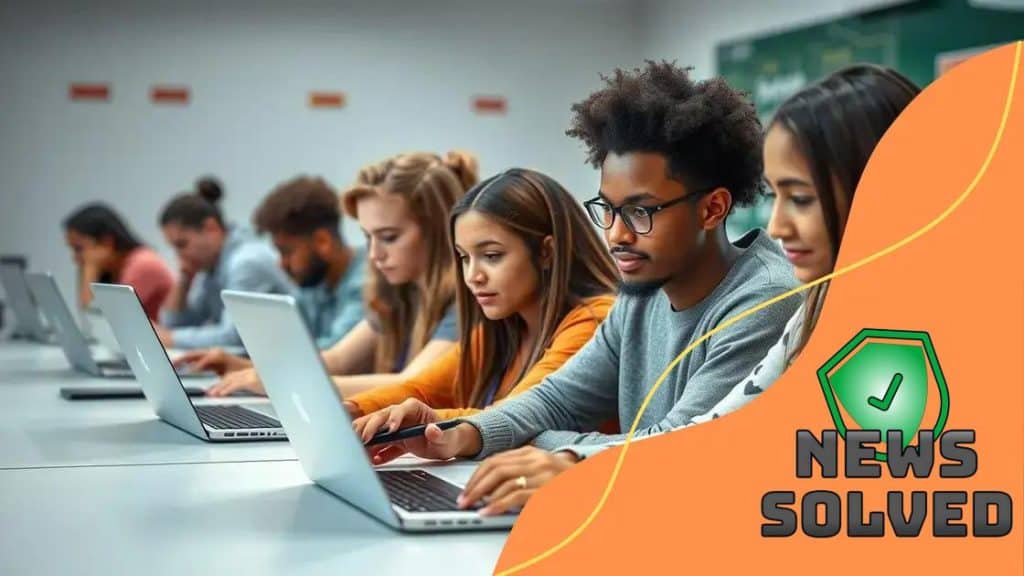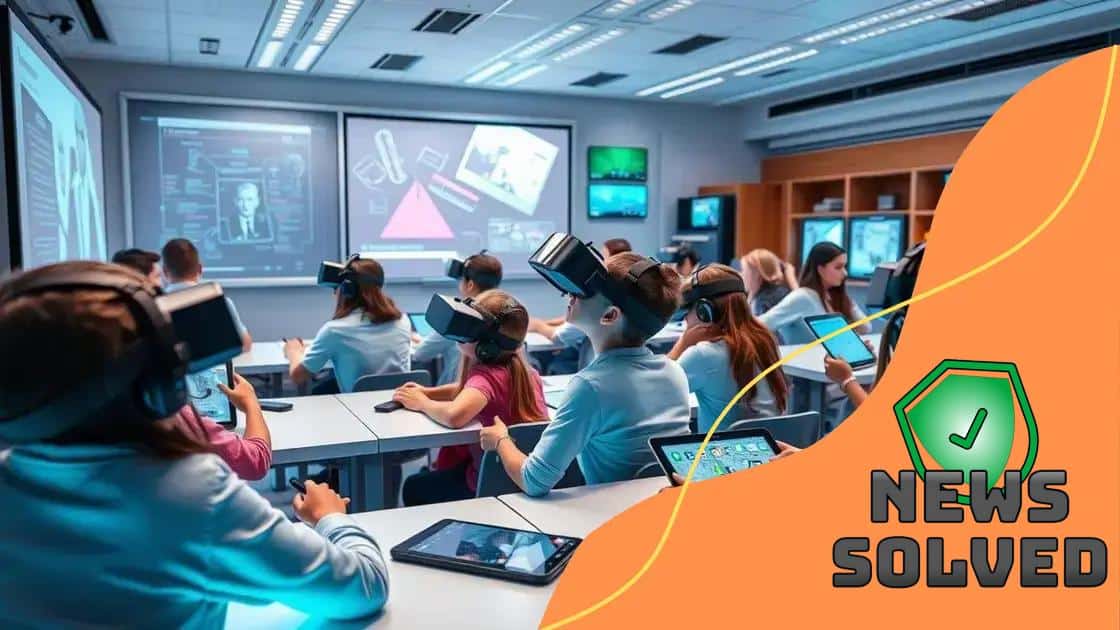How schools are addressing the digital divide in education

Advertisements
Schools are addressing the digital divide in education through community partnerships, innovative technologies, and a focus on digital citizenship, ensuring all students have equitable access to resources and opportunities.
How schools are addressing the digital divide in education is a pressing issue today. Many students lack access to essential resources, leaving them at a disadvantage. What can schools implement to ensure every learner thrives in the digital age?
Advertisements
Understanding the digital divide in education
Understanding the digital divide in education is essential as it shapes how students learn today. This gap affects many children, particularly in underserved areas. The challenge is not just about having devices but also about having reliable internet access and the skills to use technology effectively.
To grasp the digital divide better, we need to look at its causes and effects. The divide can stem from various factors including socio-economic status, geographic location, and educational system disparities. It can lead to significant differences in learning experiences between students.
Key factors contributing to the digital divide
- Income inequality: Families with lower incomes may struggle to afford internet subscriptions or devices.
- Geographic barriers: Rural areas often lack the infrastructure for high-speed internet.
- Access to technology: Schools in affluent areas typically have more resources for technology than those in poorer districts.
The consequences of this divide are profound. Students without internet access at home miss out on important learning opportunities. They may fall behind their peers who have access to online resources. Moreover, the effects can be long-lasting, impacting not only their education but also future job prospects.
Advertisements
As we delve into the issue, it becomes clear that understanding the digital divide is just the beginning. Initiatives to provide equal access are critical. Schools and communities must work together to bridge this gap and create an equitable educational landscape for all students.
The role of schools in bridging gaps
The role of schools in bridging gaps in the digital divide is crucial for ensuring that all students receive equal educational opportunities. Schools are often at the forefront of initiatives designed to connect students with necessary resources and technology.
They play a significant part in identifying students who lack access to the internet and devices. By collecting data on students’ needs, schools can develop targeted programs that address these disparities. Many schools have also implemented loan programs to provide students with laptops and tablets for home use.
Innovative strategies schools are using
- Community partnerships: Collaborating with local organizations can bring additional resources and expertise.
- Mobile hotspots: Schools are providing portable internet devices to students without access at home.
- After-school programs: Extra sessions can help students get familiar with technology and internet resources.
Additionally, teacher training is vital in this effort. Educators need the skills to integrate technology into their teaching effectively. Professional development helps teachers learn how to use digital tools and teach students to leverage them for learning.
Emphasizing digital literacy is another area where schools are making a difference. By incorporating digital skills into the curriculum, students can develop the competencies needed to thrive in a technology-driven world. This focus ensures that they are not only consuming digital content but also creating it.
Ultimately, schools must continue to adapt and innovate to meet the challenges posed by the digital divide. By actively working to bridge these gaps, they can help ensure that every student has the chance to succeed, regardless of their background.
Innovative technologies used in classrooms

Innovative technologies used in classrooms are reshaping the education landscape. With the rise of digital tools, teachers can provide more engaging and effective learning experiences for their students.
One of the leading technologies in classrooms is interactive whiteboards. These boards allow teachers to present lessons interactively, making it easier for students to engage with the content. Students can participate by answering questions, solving problems, or displaying their work directly on the board.
Popular technologies enhancing education
- Learning Management Systems (LMS): Platforms like Google Classroom help teachers organize coursework, track student progress, and facilitate communication.
- Virtual Reality (VR): VR can transport students to different environments, allowing them to explore places and concepts that would be impossible in a traditional classroom.
- EdTech Apps: Applications designed for education cover various subjects and skills, providing personalized learning experiences.
Additionally, adaptive learning technologies are becoming increasingly popular. These systems assess students’ learning styles and pace, providing personalized content to meet individual needs. By adapting to each student’s unique abilities, these technologies help ensure that no one is left behind.
Another area of growth is collaborative tools. Platforms like Zoom or Microsoft Teams enable remote learning, allowing students to work together on projects, even from home. These tools foster teamwork and communication, essential skills for the modern workforce.
Incorporating technologies into the classroom enhances learning and prepares students for the future. As schools continue to embrace these tools, the potential for improved educational outcomes grows significantly.
Community partnerships for better access
Community partnerships for better access are essential in addressing the digital divide in education. Schools cannot tackle this issue alone; collaboration with local organizations, businesses, and government entities can make a significant difference.
Many schools are forming alliances with nonprofits that provide technology resources. These organizations often donate devices or internet access services, helping to bridge the gap for students who lack the necessary tools for learning.
Key elements of successful community partnerships
- Resource sharing: By pooling resources, schools and community organizations can provide better services.
- Vocational training: Community partners can offer workshops that teach digital skills to students and parents.
- Awareness campaigns: Initiatives that highlight the importance of digital access can mobilize local support and funding.
In addition, businesses play a vital role by offering internships and mentorship programs. These initiatives give students hands-on experience with technology, preparing them for future careers. Through mentorship, students gain valuable insights and support from professionals in the field.
Moreover, local governments can contribute by improving infrastructure. Investments in broadband internet access can ensure that all students have the connectivity they need for online learning. Close collaboration with city planners can facilitate this process, making technology accessible to everyone.
Overall, effective community partnerships create a supportive ecosystem that improves educational access and equity. When schools, organizations, and communities come together, they can develop innovative solutions that enhance the learning environment for all students.
Future trends in educational technology
Future trends in educational technology are crucial for educators, students, and parents alike. As technology evolves, so does the way we approach learning. Keeping up with these trends can help create engaging and effective educational experiences.
One key trend is the increased use of artificial intelligence (AI) in education. AI can personalize learning experiences for students by analyzing their strengths and weaknesses. This allows educators to tailor lessons to each student’s unique needs, enhancing their understanding and retention of material.
Emerging technologies shaping education
- Gamification: Integrating game elements into learning can make lessons more interactive and enjoyable, encouraging student participation.
- Virtual Reality (VR): VR offers immersive experiences that can transport students into different environments, making learning more engaging.
- Augmented Reality (AR): AR can enhance traditional lessons by overlaying digital information in the real world, helping students visualize complex concepts.
Another important trend is the rise of remote and hybrid learning models. These models provide flexibility, allowing students to learn at their own pace and from various locations. This approach ensures that learning can continue even if a student cannot physically attend school.
Additionally, we can expect to see a growing emphasis on digital citizenship education. As students become more engaged with technology, understanding how to navigate the digital world safely and responsibly is essential. Teaching digital citizenship prepares students for positive online interactions and helps them develop critical thinking skills.
Finally, we might witness advancements in data analytics, which can improve educational outcomes. Schools will increasingly use data to track student progress and implement strategies to address learning gaps. This data-driven approach can help ensure that all students receive the support they need.
FAQ – Frequently Asked Questions about Addressing the Digital Divide in Education
What is the digital divide in education?
The digital divide refers to the gap between those who have easy access to digital technology and the internet, and those who do not, affecting educational opportunities.
How do community partnerships help close the digital divide?
Community partnerships can provide resources, funding, and support to schools, helping to bring technology and internet access to underserved students.
What are some examples of innovative technologies being used in classrooms?
Examples include virtual reality (VR) for immersive experiences, artificial intelligence (AI) for personalized learning, and gamification to make lessons more engaging.
Why is digital citizenship education important?
Digital citizenship education teaches students how to use technology safely and responsibly, preparing them for interactions in the digital world.





